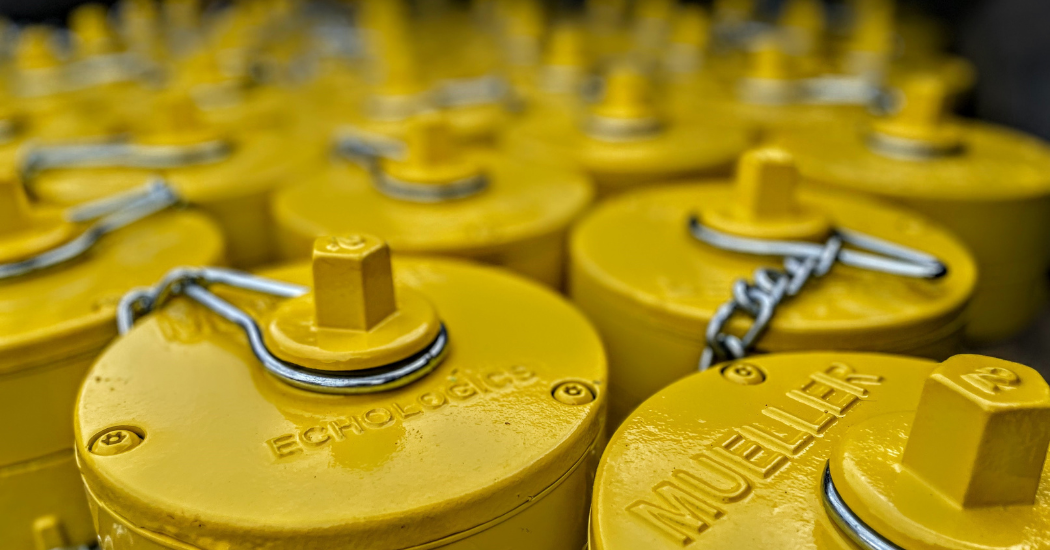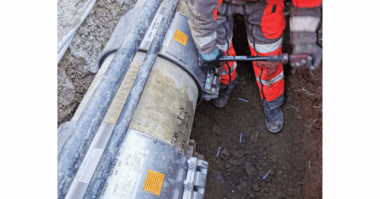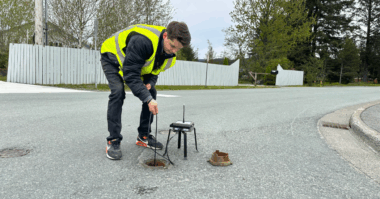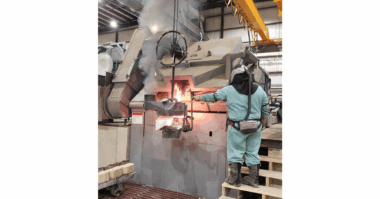Leaks in critical water networks often go unnoticed for years. The expensive damage caused can be catastrophic to critical assets, operational efficiency, and the environment.
Every asset in the water network infrastructure has the potential to fail, to leak, to break, and to cause harm to other components. Leaks cost money. They cause damage to the environment, damage to network, and require unnecessary additional work. However, with the right technology in place, water leaks can be detected sooner and the impact of them can be significantly reduced.
That’s why Echologics, a Mueller brand, created EchoShore®-DX and DXe technologies—permanent acoustic-based leak detection systems deployed on existing fittings within a distribution system of small diameter pipes. The technology regularly monitors leaks within a pipe infrastructure network.
Sensors are deployed throughout the distribution network (fire hydrants or valves) and record acoustic data daily—in the early morning hours when it’s the quietest. The data is recorded and uploaded nightly to a backend server. The nodes (sensors, batteries, processors, and antenna) components are on site. Each device has a SIM card that transmits acoustic data to the cloud network.
The sensors do not create alerts. Rather, they passively record data daily. The alert comes after analysis on the backend. Data is analyzed with the help of artificial intelligence that is then reviewed by expert data analysts, who then make any necessary recommendations to the utility.
The data is analyzed in two ways.
1. With a single channel format, in which data captures sounds around the sensors.
Comparing the data collected by two of the sensors throughout the network. “This works with correlation, which listens to determine whether two sensors are hearing the same noise,” explains Asha Budhlall, Echologics Product Launch Manager. “If they are, we can locate where that noise is along the network. From that data, we can identify where resources should be deployed onsite to investigate the potential leak. The fact that we can find the leak location is actually not the critical part. It’s the fact that we can track the location of sounds in the water network over time. Then we get to use a key fact about water leaks. They don’t move around! The ability to check that a sound is in the same spot night after night, helps us to gain confidence that it is a leak and worth the utilities time to investigate.”
Echologics was acquired by Mueller more than 15 years ago because Mueller saw the need and opportunity to bridge technology with infrastructure for network and asset management, as a whole. Echologics has integrated solutions as a standalone and working with other groups to collaborate on products and technology to support an overall holistic solution for utilities and network managers.
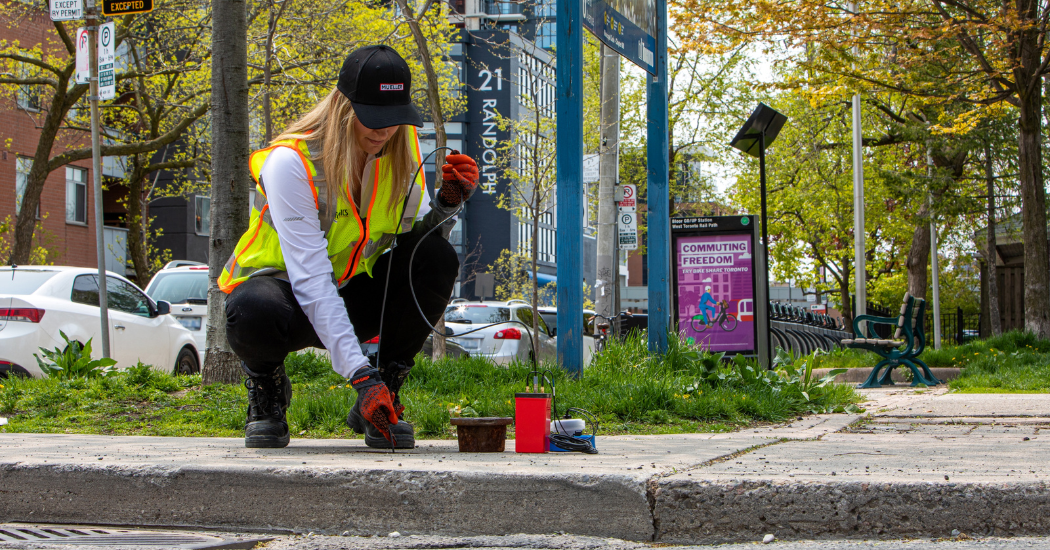 Advancements in Leak Detection
Advancements in Leak Detection
EchoShore is a leak detection system with two components—hardware and a leak detection intelligence system.
The original EchoShore product was introduced more than eight years ago and has since been in use in North America and around the world. EchoShore-DX integrates a sensor, processor, and communications into a pumper nozzle of a fire hydrant. Utilities deploy them by replacing pumper nozzles with cap sensors—which are easily installed, easily maintained, and easily communicate on local cell networks.
“While hydrants are readily available, they don’t capture the entire pipe network,” Budhlall says. “Some distribution mains within the network may not be monitored because of a lack of hydrants along those lines. To solve this issue, EchoShore-DXe (e is for external) was recently launched. This technology has an external sensor—surface mounted and magnetic—that can be externally attached to a valve or similar fitting.”
The DX and DXe sensors are interchangeable and can be deployed together in a mesh network to get optimal coverage or leverage the easiest installation options. It provides a supplement to an existing network and ultimately provides more coverage for leak detection.
“Utilities can now have a better overview of their entire networks with more flexibility of installation,” she explains. “From a hardware perspective, the smaller integrated design allows for more flexibility within networks. That’s the biggest hardware advancement so far.”
Echologics has another sensor type—TX sensor—which is designed entirely for large diameter transmission pipes. This offers leak monitoring on critical large water pipelines that transport water long distances and often make up the backbone of a water network.
With regard to leak detection intelligence, there are three key advancements—leak sizing, leak scoring, and a mobile app for leak feedback.
Leak Sizing
Thanks to the high number of DX sensors deployed in North America, Echologics has collected a significant amount of data through the years. This has resulted in the development of effective tools to support existing and future data analysis.
One example is leak sizing, which allows alerts to be sent to utilities. “Not only do they receive the alert, but a predictive leak size is provided which gives an estimate of the flow rate,” Budhlall explains. These predictions are based and modeled on actual data that has been gathered from about 400 confirmed leak flow rates. The predictions are built on machine learning.
This information is vital for risk mitigation. It allows utilities to be more efficient in their operations and avoid catastrophic failures because it allows them to prioritize repairs and monitor repair events.
Leak Scoring
Because of the amount of knowledge gained from the significant data collected, leak scoring is similar to leak sizing, Budhlall says. “We differentiate and provide indicators as to why or if something is likely to be a leak based on roughly 190 acoustic attributes, and then a score is assigned to it. This was machine learned after four years of collecting data. Individual features can be targeted (like coherence, for example) and assigned a score. The score appears as a percentage, which helps to indicate whether something is likely to be a leak.”
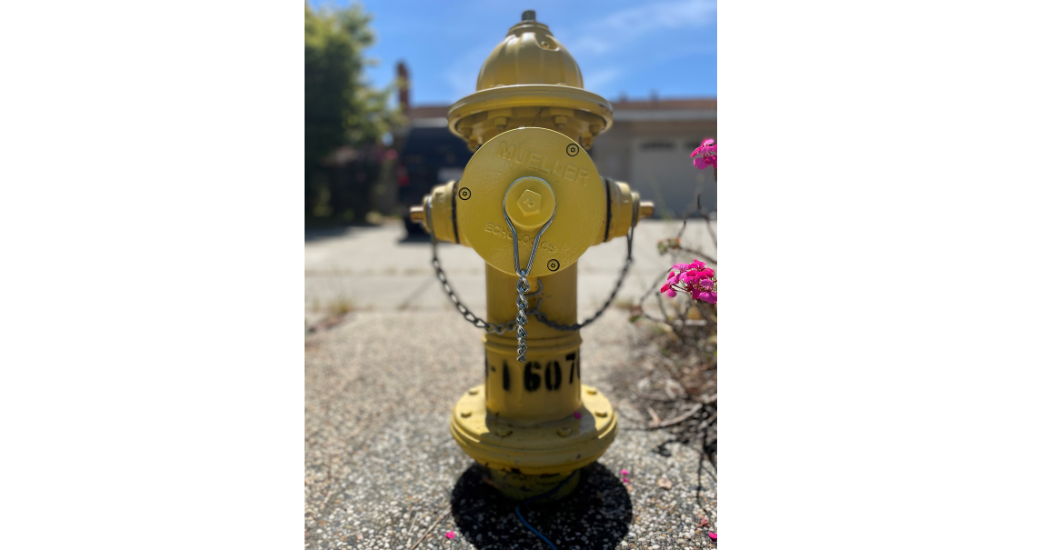 A human data analyst makes the decision whether to push the activity forward to the utility for investigation. This provides an additional layer of confidence in reporting leaks. For utilities, it reduces the number of false positive alerts and unnecessary truck rolls to the site.
A human data analyst makes the decision whether to push the activity forward to the utility for investigation. This provides an additional layer of confidence in reporting leaks. For utilities, it reduces the number of false positive alerts and unnecessary truck rolls to the site.
Mobile App for Alert Feedback
Sentryx™ is an interface on which the system provides alerts. It’s a web-based app that gives users information about alerts, but also collects feedback from the field. Leak detection operators on site receive information at their fingertips about the event along with notes from the analyst. The operator can then provide more notes after the inspection with specific details about size, flow rate, etc. Along with the ease of access to information, the data is instantly collated into one central place.
Future informed decisions can be made based on the feedback from the utilities. The feedback in the app can be used in the long term. The data collected influences and informs future insight and more advanced technologies. This type of machine learning improves future leak detection accuracy and efficiency and helps with continuous improvement efforts.
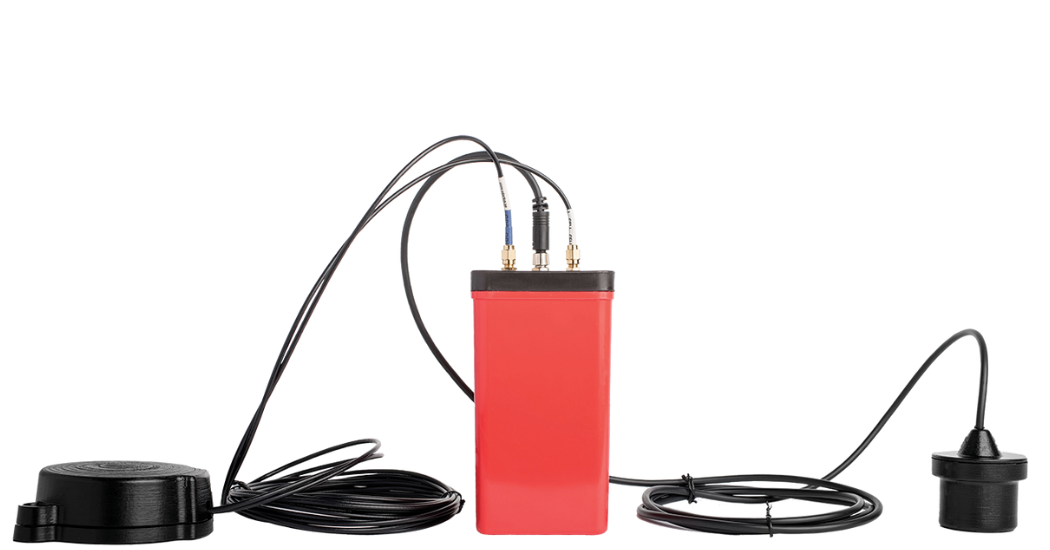 Why Leak Detection Matters
Why Leak Detection Matters
The overriding reasons for accurate leak detection are risk mitigation and cost. However, there are four specific reasons that leak detection is important to water networks.
- Catastrophic failures and safety events. Leak sizing is effective in identifying potential leaks that are larger than others. They can be prioritized to be repaired first before they have the potential to cause more damage. This is also referred to as “finding leaks when they are young,” before they become a bigger problem. “This is a benefit of a permanent leak detection system as opposed to a one-time survey,” Budhlall says. “Permanent systems continuously find smaller leaks before they become catastrophic. It’s a risk mitigation tactic. You can be proactive with the repair.”
2. Cost. Water conservation is important, but cost is what creates a business case for taking action, Budhlall explains. “The first way to think about this is non-revenue water reduction—reducing the amount of revenue-producing water that is escaping the system. The cost of water, in general, for the utility is also a factor—how much is spent in pumping, treating, and pushing water out to your network. For utilities with a higher cost of water, especially when water is purchased from another system, this is even more significant.”
There is also a cost related to energy consumption. Unnecessary pumping and treating leads to unnecessary costs that can be avoided. There is a huge cost associated with catastrophic failure, especially if a leak is unnoticed too long and breaks at the wrong location—creating cost of repair, as well as cost of damage to surrounding infrastructure. In addition, there is a high cost of downtime and costs associated with operational efficiency.
3. Environmental protection. Consider the damage to the environment caused by treated or chlorinated water. Leaks into freshwater systems can damage the surrounding ecosystem. There is a carbon emissions component that results from the pumping and treating. And finally, water scarcity is a global concern, which requires intentionality surrounding water use.
4. Compliance. In North America, there is more regulatory and standard compliance guidelines that vary throughout the states. This creates a stronger need for utilities to meet certain targets and to be more accurate with leak detection resources.
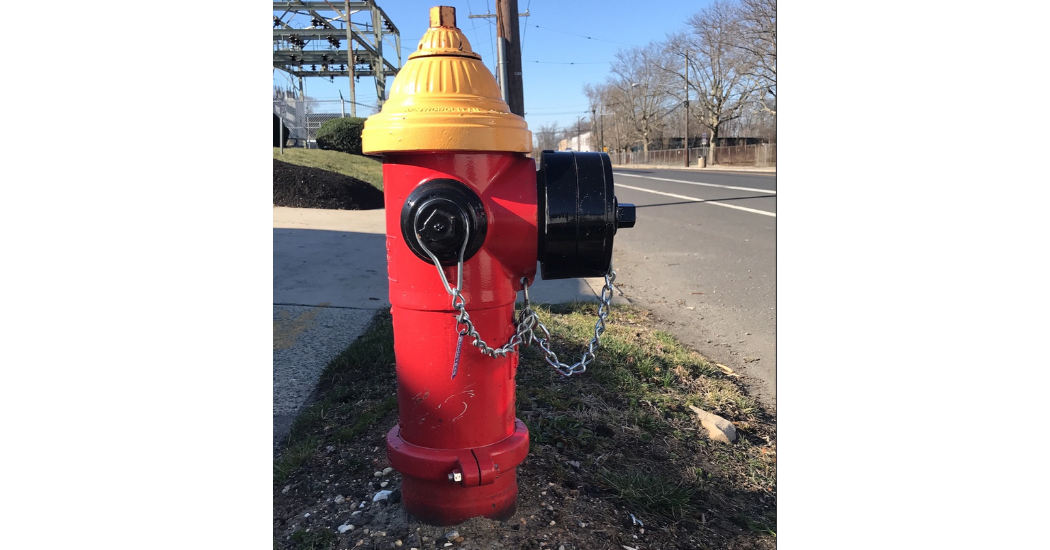 Applications Using Leak Detection Technology
Applications Using Leak Detection Technology
Different utilities have different drivers, but the bottom line is finding leaks when they are smaller and deploying in critical areas where there is a high consequence of failure.
“It all relates to what impact will a break on this pipe have on the surrounding environment,” Budhlall says. “In densely populated areas where the person per foot of pipe is high it’s an ideal location for advanced leak detection technology. There is also a strategy for using it in areas with critical infrastructure—like close to highways, airports, and stadiums.”
Some utilities deploy the technology where the cost of water is highest. There is an operational component, as well. The demand for what is needed from operators can be significant. Areas where crews cannot be deployed regularly, or areas where there is a safety component, are good candidates for permanent leak detection systems.
Case Studies
1. An environmentally-driven utility on the west coast deployed EchoShore-DX based on their need to reduce the volume of treated water flowing into fresh water sources. Sensors were deployed in very strategic areas. Rather than deploying in a cluster, they placed sensors where there was distribution pipe that overlapped or was near a fresh water source. Smaller leaks were detected before they became dangerous to the fresh water streams, reducing the impact on the environment. Since the initial deployment, the system has been expanded to enhance the location of the sensors to include additional critical infrastructure components.
2. At a remote east coast utility, a small number of EchoShore-DX sensors were deployed when they recognized that they had significant water losses within their system. Because of the remote location, it was difficult to deploy operators on a regular basis in a timely manner. Even proactive activities were expensive. Within a year of deploying EchoShore-DX, the utility was able to defer some capital spend for a secondary water source for that network. It’s a good example of how a good leak detection system as part of a larger program can support reduction of capital spend on additional storage, secondary pipelines, and infrastructure-related damage.
3. A large, private west coast utility was interested in investing in a permanent leak detection system because of their water conservation initiatives. They wanted to improve the efficiency of their system as a whole and improve their ability to find the subsurface leaks. More than 8,000 sensors were deployed throughout their network consistently over the course of several years. The system compliments their leak detection operators on site who are skilled at pinpointing the investigation of leaks. Along with improved efficiency, their customer service also improved because of the reduction in service repairs required.
Leak detection is very powerful technology—a specific tool to be added to a utility’s toolbox, Budhlall explains. “The intent is to support utilities that are building a leak detection program. If users are already onsite doing investigations, this technology will enhance that foundation. For utilities just starting to implement a program, Echologics’ experience can be a huge asset. The successes we’ve seen have been with those we work with as partners. We want to learn from our clients and work with them in partnership to learn more about their systems. When we get smarter, our technology gets smarter. Our brand is all about continuous improvement.”
 Michelle Segrest is president of Navigate Content, Inc., and has been reporting on the processing industries since 2008. She is the author of three books on Modern Manufacturing and can be reached at michelle@navigatecontent.com
Michelle Segrest is president of Navigate Content, Inc., and has been reporting on the processing industries since 2008. She is the author of three books on Modern Manufacturing and can be reached at michelle@navigatecontent.com

